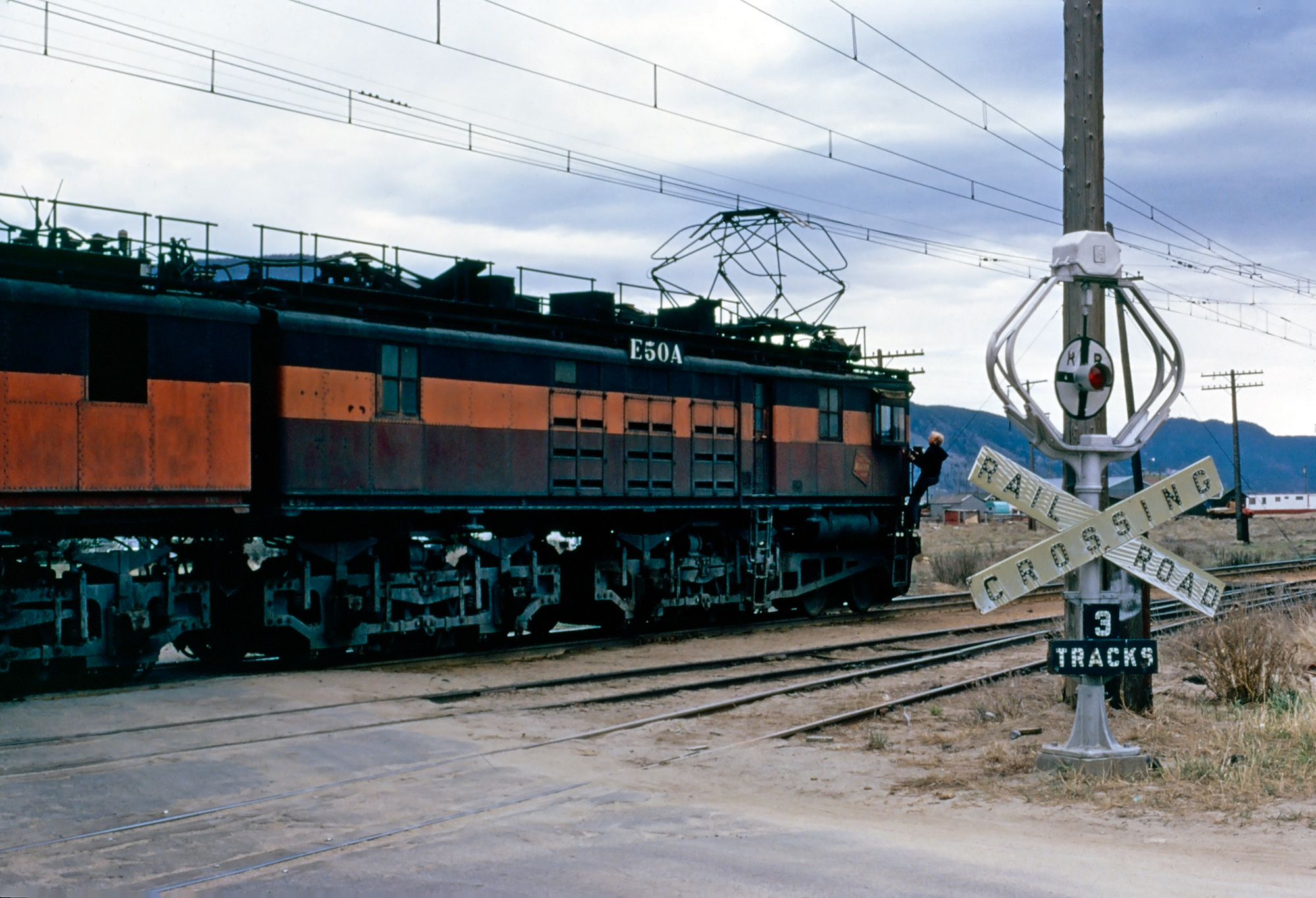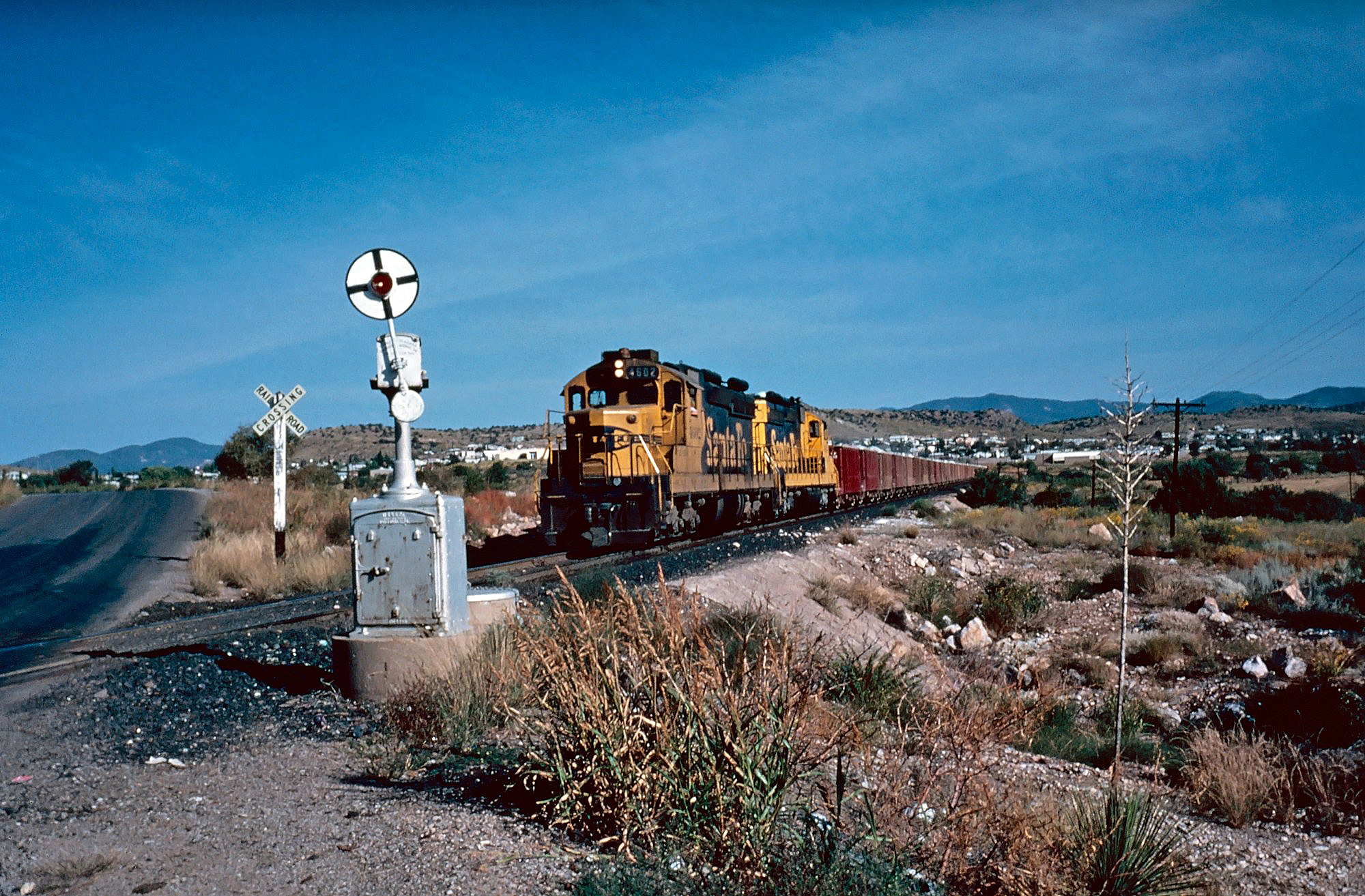The Wigwag: Classic Grade-Crossing Signals
Last revised: September 4, 2024
By: Adam Burns
In the early 20th century, a distinctive type of railroad signal known as the "wigwag" became a familiar sight at many railroad grade crossings across the United States.
These mechanical marvels served as vigilant guardians, warning motorists and pedestrians of approaching trains and enhancing safety at crossings.
Though largely replaced by more modern systems today, wigwags have left an indelible mark on railroading history and hold a special place in the hearts of rail enthusiasts. This article explores the history, functionality, cultural significance, and eventual decline of the beloved wigwag signal.
 Milwaukee Road boxcab E50A and other motors were photographed here at the yard in Butte, Montana in May, 1973. Note the classic wig-wag crossing signal. Photographer unknown. American-Rails.com collection.
Milwaukee Road boxcab E50A and other motors were photographed here at the yard in Butte, Montana in May, 1973. Note the classic wig-wag crossing signal. Photographer unknown. American-Rails.com collection.Birth of the Wigwag Signal
Origins and Development
The development of the wigwag signal can be traced back to the early 1900s, a time when the rapid expansion of railway networks in the United States posed increasing safety challenges at railroad grade crossings.
The need for a reliable and effective warning system became critical as automobiles became more common, and the potential for collisions at crossings escalated.
The first wigwag was designed and patented by Albert Hunt, an engineer for the Los Angeles-based Pacific Electric Railway Company, in 1909. Hunt's innovation aimed to create a visible and attention-grabbing signal that would effectively warn approaching motorists and pedestrians of an oncoming train.
Design and Mechanism
The classic wigwag signal consisted of a vertical mast, at the top of which was a box containing an electromagnetic mechanism. This mechanism drove the distinctive "wigwagging" motion of the red and white metal target or banner, which hung below the box.
When a train approached, the electromagnet would activate, causing the banner to swing back and forth in a pendulum-like motion, simulating a wagging finger. In addition, a lamp was often mounted on the target, illuminating it and reinforcing its visibility at night or in poor weather conditions.
A key feature of the wigwag signal was its simplicity and mechanical reliability. The motion of the banner and the flashing lamp provided a visual and auditory warning that was more effective than static signs or non-mechanical devices.
The wigwag's design was robust and could function in various environmental conditions, making it a preferred choice for many railroads.
Functionality: How Wigwag Signals Work
Activation and Operation
Wigwag signals were typically activated by the train itself as it approached a crossing. A common method of activation involved the use of a track circuit, a section of track that was electrically isolated and wired to detect the presence of a train. As the train entered the track circuit, it would complete the electrical circuit, triggering the wigwag signal to operate.
1. **Detection**: As the train approached, it would enter a track circuit, completing an electrical connection that activated the wigwag signal.
2. **Movement**: The electromagnet within the signal's mechanism would energize, causing the banner to begin its oscillating motion. This distinctive back-and-forth movement provided a clear warning of the impending train.
3. **Illumination**: Simultaneously, the lamp on the target would begin flashing, adding a visual cue to the mechanical motion. Some wigwags also included a bell that would sound as the banner swung, further enhancing the warning with audible alerts.
4. **Deactivation**: Once the train had passed through the crossing and exited the track circuit, the electrical connection would be broken, causing the signal to deactivate. The banner would come to rest, and the lamp would cease flashing.
 A classic wigwag protects a grade-crossing near Deming, New Mexico as a pair of Santa Fe SD26s, led by #4602, has an ore train about to cross the roadway, circa 1982. Mike Bledsoe photo. American-Rails.com collection.
A classic wigwag protects a grade-crossing near Deming, New Mexico as a pair of Santa Fe SD26s, led by #4602, has an ore train about to cross the roadway, circa 1982. Mike Bledsoe photo. American-Rails.com collection.Variations and Adaptations
While the basic design and operation of wigwags remained largely consistent, several variations and adaptations emerged over the years to address different operational needs and environmental conditions.
- **Undercut Arm Wigwags**: Some wigwags featured an undercut arm design, where the metal target was attached to the lower end of the pendulum rod. This design was intended to prevent the arm from striking obstacles or the ground during windy conditions.
- **Magnetic Flagmen**: A variation known as the "magnetic flagman" incorporated a swinging target with a crossbuck sign. This design enhanced visibility by combining the wigwag motion with the familiar crossbuck symbol.
- **Rotating Wigwags**: Some regions, particularly in the Pacific Northwest, saw the use of rotating wigwag signals. Instead of oscillating, these signals used a rotating mechanism to create a distinctive warning motion.
- **Cantilever Designs**: Some wigwags featured a fully cantilevered mast either atop - or just below - the signal mast upon which was attached a "Railroading Crossing" crossbuck. These types sometimes also had signs attached denoted the number of tracks and "Stop When Swinging" or "Stop When Ringing."
Cultural Significance and Iconic Status
Impact on Rail Safety
The widespread adoption of wigwags had a significant impact on rail safety, particularly at grade crossings. Their robust and attention-grabbing design helped reduce accidents and collisions by providing a clear and reliable warning to motorists and pedestrians.
Iconic Status
Beyond their functional role, wigwags achieved iconic status in American railroading culture. They became synonymous with the golden age of railroads and were often featured in classic films, literature, and even toys.
The distinctive swinging motion and the rhythmic clang of the signal bells evoked a sense of nostalgia and romance associated with the era of steam locomotives and bustling rail lines.
Preservation and Enthusiast Appeal
While wigwag signals can rarely be found in service today, many rail enthusiasts and preservation societies have worked diligently to restore and maintain these historical artifacts.
Some wigwags have been restored to full operational status and are used in heritage railway operations, allowing new generations to experience their unique charm.
Decline and Modern Alternatives
Technological Advancements
The eventual decline of wigwags can be attributed to the advent of more advanced and reliable warning systems. The development of modern electronic crossing signals, such as flashing light signals, gates, and bells, offered several advantages over the mechanical wigwags.
Electronic signals provided more consistent and fail-safe operation, with fewer moving parts that could wear out or malfunction. The use of gates added an additional layer of protection by physically blocking the crossing, further reducing the risk of collisions.
Regulatory Changes
Regulatory changes and safety standards also played a role in the phasing out of the wigwag. As safety requirements became more stringent, railroads were encouraged or mandated to adopt newer technologies that could provide higher levels of safety and compliance.
Conclusion
The wigwag stands as a testament to the ingenuity and innovation of early 20th-century railway engineers.
Its distinctive swinging motion, combined with the flashing lamp and rhythmic bell, provided an effective and reliable warning system that greatly improved safety at railroad grade crossings.
While largely replaced by modern electronic systems, the wigwag signal remains an iconic symbol of railroading history, evoking a sense of nostalgia and admiration among rail enthusiasts and historians.
As we reflect on the legacy of the wigwag, we are reminded of the critical role that technology plays in enhancing safety and efficiency in transportation.
The wigwag's contribution to rail safety paved the way for future innovations, ensuring that the principles of vigilance and protection continue to guide the evolution of railroad crossing technologies.
Recent Articles
-
A Murder Mystery Dinner Train Ride In Pennsylvania's Amish Country
Oct 20, 25 10:50 AM
In recent years, the railroad has also become known for themed excursions that pair history with hospitality, including an especially popular offering: the Murder Mystery Dinner Train. -
Washington's ~Murder Mystery~ Dinner Train Rides
Oct 20, 25 10:44 AM
This article delves into what makes murder mystery dinner train rides in Washington State such a captivating experience. -
West Virginia's ~Murder Mystery~ Dinner Train Rides
Oct 20, 25 09:27 AM
For those looking to combine the allure of a train ride with an engaging whodunit, the murder mystery dinner trains offer a uniquely thrilling experience.



